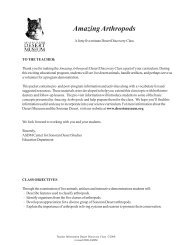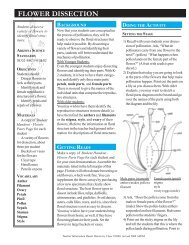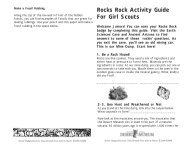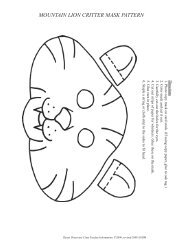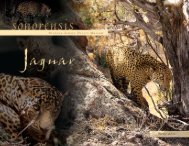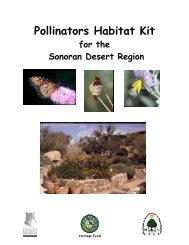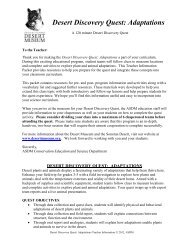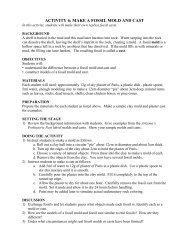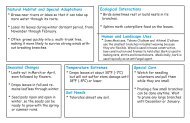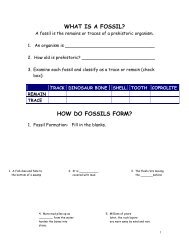Adaptation: A Way of Life - Arizona-Sonora Desert Museum
Adaptation: A Way of Life - Arizona-Sonora Desert Museum
Adaptation: A Way of Life - Arizona-Sonora Desert Museum
Create successful ePaper yourself
Turn your PDF publications into a flip-book with our unique Google optimized e-Paper software.
ADAPTATION: A WAY OF LIFEPLANT AND ANIMALDESERT ADAPTATIONSActivities that showhow desert plants andanimals are welladaptedto life in thedesert and thrive withlittle moisture and hightemperatures.ARIZONA SCIENCESTANDARDSSC00-S4C3-01,SC00-S1C1-02,SC01-S1C1-02,SC03-S4C4-01OBJECTIVESStudents should:• Recognize that allliving things areadapted to their nativesurroundings in orderto survive. <strong>Adaptation</strong>sinclude behaviorsor body characteristics.• Understand thechallenges heat andaridity pose to desertlife.• Examine howspecific plant andanimal strategies helpthem preserve moistureand stay cool.GETTING READYPrepare the materials as listed in the leftmargin <strong>of</strong> the next page.DOING THE ACTIVITYSETTING THE STAGE1) Ask the students, “Do you think it ishard for plants and animals to live in thedesert? Why?” (Possible answers includethat it is hot and dry, there is not muchwater, and that evaporation is high.)2) Explain that the desert can be a hardplace to live, but for animals and plantsthat know how to live here, it is not sochallenging. They have adaptations -special things about their bodies or theway they behave - that help them survivethe heat or dryness <strong>of</strong> the desert. Discusssome examples <strong>of</strong> adaptations <strong>of</strong> peopleand animals. (People have large brains tohelp them create things. Eagles havetalons to help them grab their prey.) Tellthe students they are going to do someactivities that show how adaptations <strong>of</strong>desert dwellers help them save water andkeep cool. We’ll start with plants.PLANT STRATEGIES FOR SAVINGWATER AND KEEPING COOLACTIVITIESADAPTATION 1: SUCCULENCE1) Pass out the squares <strong>of</strong> paper towel andwax paper and arrange the water jarswith eyedroppers or spoons so they areavailable for each child. Give the studentsa few moments to put water on theirdifferent squares and observe the results.Ask: “What happens when you put waterdrops on the paper towel? On the waxpaper?” (Possible answers: the towelsabsorb the water, while the wax paperrepels it or keeps it from penetrating thepaper.)2) Ask the students: “In the story Seasons<strong>of</strong> Saguaro, what did Saguaro dowhen it rained?” (She sucked up thewater with her roots and stored it inside<strong>of</strong> her stem.) “Which do you think theinside <strong>of</strong> Saguaro’s stem is more like,the paper towel or the wax paper?”(paper towel) Explain that many desertplants such as cacti are like the papertowel inside their stems and leaves.Having spongy, absorbent tissue is anadaptation to help desert plants saveprecious water to use when it is dry.3) Tell the children, “Now watch this!”Perform the following demonstration.DEMONSTRATION 1: SUCCULENCE1) Dip the sponge in a bucket <strong>of</strong> waterand dab it on the blackboard in twosmall splotches a few inches wide and afoot apart. Working quickly so thewater splotches do not evaporateimmediately, cover one with a square <strong>of</strong>paper towel and tape the edges downso little air enters from the edges.Repeat the process with a square <strong>of</strong>wax paper.2) Let the samples begin to evaporate.Ask the students, “Which do you thinkwill evaporate more quickly, the waterunder the wax paper or under thepaper towel?” (The water under thepaper towel.) Field their responses andwatch as a group to determine whichone evaporates more quickly.3) Discuss their observations. Ask, “Howdo you think Saguaro keeps rainwaterinside <strong>of</strong> her from evaporating?” “Hint:the trick is in the skin.” (Saguaro has awaxy coating on its stem to trap thewater inside.) Explain that many desertplants have waxy stems and leaves thatkeep water from evaporating easily.This is an adaptation to help savewater.Self-Guided Visit Information and Activities © 2000, revised 2007 ASDM
ADAPTATION: A WAY OF LIFEMATERIALS• a square <strong>of</strong> waxpaper and a square <strong>of</strong>paper towel for eachstudent (plus a set forteacher demonstration)• eyedroppers orspoons available in jars<strong>of</strong> water for use by eachstudent• blackboard• sponge• masking tape• buckets <strong>of</strong> water• hedgehog cactuscard image (last page <strong>of</strong>this activity)• prickly pear cactuscard image (last page <strong>of</strong>this activity)• copies <strong>of</strong> “<strong>Desert</strong><strong>Adaptation</strong>s” worksheetVOCABULARY• <strong>Adaptation</strong> - abody part or behavior<strong>of</strong> an animal or plantthat helps it live in itsenvironment (example:an eagle has sharptalons that help it grabits prey.)• Nocturnal - activeat night.4) (Optional) Make a model prickly pearpad (instructions below) and ask thestudents to explain how it represents areal prickly pear pad. (The wax paper“skin” covers the inner paper napkin“tissue, ” preventing water loss.)PRICKLY PEAR PAD MODELMATERIALS:• two 12” sheets <strong>of</strong> wax paper• green paper towels or napkins (6 x 6inches) (5 to 10)• toothpicks• scotch tapeINSTRUCTIONS:1) Assemble the above materials.2) Cut the wax paper into paired circlesabout 7 inches in diameter.3) Stack the wax paper circles and tapethe edges about half way around,forming a pocket.4) Stack the green paper napkins or papertowels and fold them into the wax paperpocket.5) Seal the rest <strong>of</strong> the edge with morescotch tape, leaving an inch or two opento show the napkins inside.6) Stick toothpicks into both sides <strong>of</strong> thepad in clusters <strong>of</strong> two or three spaced attwo inch intervals.5) If you have a prickly pear cactus in yourhome garden or on school grounds, cut across section <strong>of</strong> a pad to show thestudents. Ask them to describe what theysee and relate it to the activity.ADAPTATION 2: SHADE AND LEAFANGLE1) Bring the buckets <strong>of</strong> water, card <strong>of</strong> ahedgehog cactus, and the children outsideand gather in a spot in direct sunlight.Ask, “Can you think <strong>of</strong> a way that desertplants keep cool?” Tell them one waywas in the Seasons <strong>of</strong> Saguaro story.(See if they remember that Saguaro firstgrew in the shade <strong>of</strong> an ironwood treeand also shaded herself with her ownspines.) Show them the hedgehog cactuscard and point out how the spines coverup the cactus underneath, shading it.2) Now have them hold their palms out flatin the sunlight for a few seconds. Thenhave them tilt their hands vertical to theground. Ask, “Which way do your handsfeel hotter, flat out or up and down?”(Holding your palms flat out absorbsmore sunlight than holding them up anddown, if you do this activity when the sunis overhead.) Explain that to keep fromgetting too hot, some desert plants suchas jojoba and prickly pear orient theirleaves or pads up and down (hold themwith the surface vertical and parallel tothe sun’s rays) instead <strong>of</strong> flat out.3) Show them the prickly pear copy cardto illustrate the pad orientation.EXTENSIONCONTINUEDIf you have desert plants on your schoolgrounds, have the students observe some <strong>of</strong>these adaptations. Have them draw theplants and describe the adaptations (orallyor written) in a science journal.Self-Guided Visit Information and Activities © 2000, revised 2007 ASDM
ADAPTATION: A WAY OF LIFECONTINUEDANIMAL STRATEGIES FOR SAVING WATERACTIVITIESAND KEEPING COOLADAPTATION 1: PANTING OR SWEATING1) Ask the children: “What happens to us when weget hot and our body tries to cool us down?” (Wesweat.) “How does sweating cool us <strong>of</strong>f?” (Oursweat evaporates and cools us.)2) To illustrate this, have the students roll up theirsleeves and dip one arm in the bucket <strong>of</strong> water,leaving the other arm dry. Have them wave botharms in the air. Ask: “Which arm is cooler? Why?”(Evaporation on the wet arm cools the air downaround the arm, making it feel cooler.) “Do youthink very many desert animals sweat?” (no)Why?” (Possible answer: few desert animalssweat because there is so little water to drink toreplace the water lost.)3) But there are other ways to keep cool. Ask,“What do dogs do to keep cool?” (pant) Explainthat when they pant, dogs’ blood is cooled as itpasses through their tongue because water evaporatesfrom dogs’ tongues and cools them down.Coyotes, mountain lions, birds, and many otherdesert animals pant to cool down.ANSWERS TO THE DESERT ADAPTATIONS HAND-OUT:There are six adaptations, covered in the activitiesabove, depicted in the handout.• a fox in its den in the heat <strong>of</strong> the day• spines on the saguaro to help shade it• a kangaroo rat coming out at night• a plant with leaves held vertically• a baby cactus growing in the tree’s shade• succulent stems and waxy skinEXTENSIONCREATE A DESERT CREATURE!The students can create and draw their own animalor plant with its own adaptations for desert survival.Have them share their creations with each other tosee if others can figure out the creatures’ adaptations.Or have them write a description <strong>of</strong> the animal/plant with its name and adaptations.ADAPTATION 2: ACTIVE AT NIGHT, RESTING INSHADE, OR SLEEPING IN A BURROW1) Ask: “Can you think <strong>of</strong> any other ways desertanimals might keep cool?” Bring up examplesfrom Seasons <strong>of</strong> Saguaro, asking: “What didJavelina do to survive the summer heat?” (laydown in the shade <strong>of</strong> a mesquite tree) “What didKangaroo Rat do?” (sleep in her undergroundburrow)2) Explain that many desert animals are active eitherat night or in the cooler hours <strong>of</strong> the day. Theypass the heat <strong>of</strong> the day resting in deep shade ordown in burrows out <strong>of</strong> the sun. Animals thatcome out at night are called nocturnal animals.3) Briefly discuss these strategies with the students,then return to the classroom and pass out the<strong>Desert</strong> <strong>Adaptation</strong>s Handout.Self-Guided Visit Information and Activities © 2000, revised 2007 ASDM
NAME_________________________________DESERT ADAPTATIONS - HANDOUTCan you find examples <strong>of</strong> 2 plant and 2 animal adaptations that helpthem save water and keep cool? Circle them and tell what they are.Self-Guided Visit Information and Activities © 2000, revised 2007 ASDM
Self-Guided Visit Information and Activities © 2000, revised 2007 ASDM



